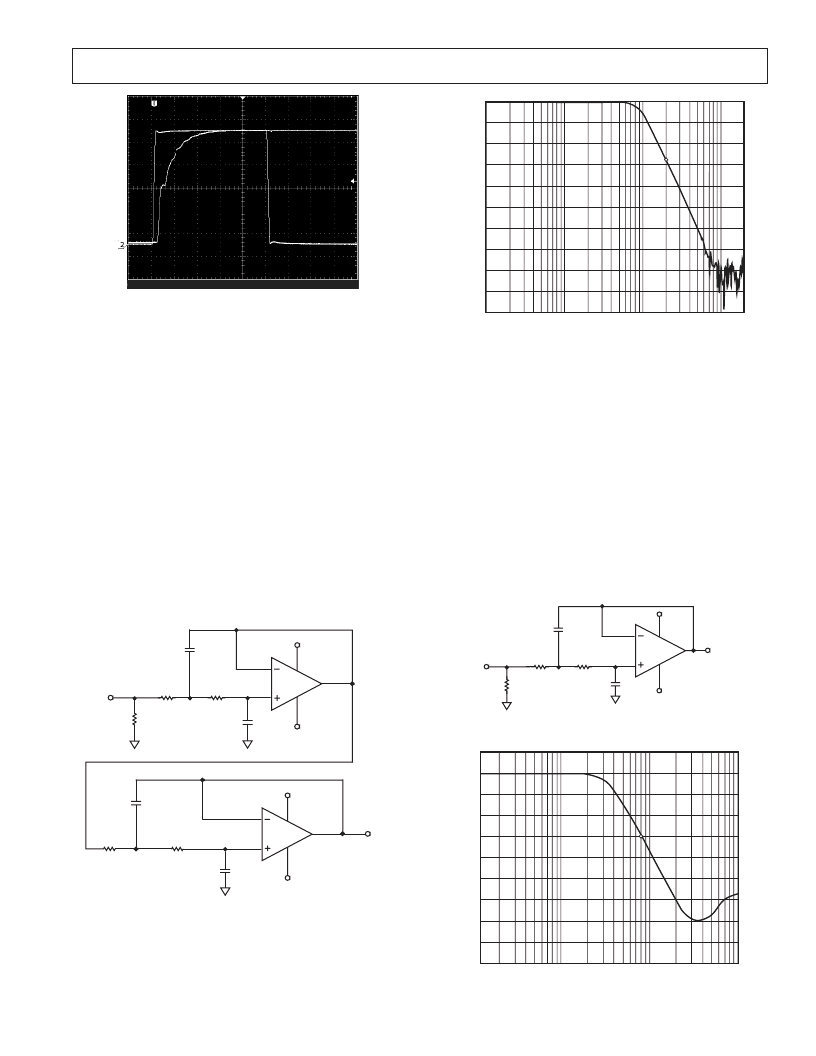- 您現在的位置:買賣IC網 > PDF目錄373931 > AD8034AR-REEL (ANALOG DEVICES INC) Low Cost, 80 MHz FastFET ⑩ Op Amps PDF資料下載
參數資料
| 型號: | AD8034AR-REEL |
| 廠商: | ANALOG DEVICES INC |
| 元件分類: | 運動控制電子 |
| 英文描述: | Low Cost, 80 MHz FastFET ⑩ Op Amps |
| 中文描述: | DUAL OP-AMP, 3500 uV OFFSET-MAX, PDSO8 |
| 封裝: | MS-012AA, SOIC-8 |
| 文件頁數: | 17/20頁 |
| 文件大小: | 374K |
| 代理商: | AD8034AR-REEL |

REV. B
AD8033/AD8034
–17–
INPUT
OUTPUT
1.00V/DIV
200nS/DIV
Figure 7. Peak Detector Response 5 V 1
μ
s Pulse
Figure 7 shows a 5 V peak pulse being captured in 1 s with less
than 1 mV of kickback. With this selection of time constants, up
to a 20 V peak pulse can be captured with no overshoot.
Active Filters
The response of an active filter varies greatly depending on the
performance of the active device. Open-loop bandwidth and gain,
along with the order of the filter, will determine stop-band
attenuation as well as the maximum cutoff frequency, while input
capacitance can set a limit on which passive components are used.
Topologies for active filters are varied, and some are more
dependent on the performance of the active device than others.
The Sallen-Key topology is the least dependent on the active
device, requiring that the bandwidth be flat to beyond the stop-
band frequency since it is used simply as a gain block. In the
case of high Q filter stages, the peaking must not exceed the
open-loop bandwidth and linear input range of the amplifier.
Using an AD8033/AD8034, a four-pole cascaded Sallen-Key
filter can be constructed with f
C
= 1 MHz and over 80 dB of
stop-band attenuation, as shown in Figure 8.
–V
S
+V
S
C2
10pF
–V
S
+V
S
V
IN
R1
4.22k
AD8034
AD8034
R2
6.49k
R5
49.9
C1
27pF
C3
33pF
R4
4.99k
R3
4.99k
C4
82pF
V
OUT
Figure 8. Four-Pole Cascade Sallen-Key Filter
Component values are selected using a normalized cascaded
two-stage Butterworth filter table and Sallen-Key two-pole
active filter equations. The overall frequency response is shown
in Figure 9.
10k
1M
10M
FREQUENCY – Hz
–100
R
–90
–80
–70
–60
–50
–40
–30
–20
–10
0
100k
Figure 9. Four-Pole Cascade Sallen-Key Filter Response
The common-mode input capacitance should be considered
in the component selection.
Filter cutoff frequencies can be increased beyond 1 MHz using
the AD8033/AD8034, but limited open-loop gain and input
impedance begin to interfere with the higher Q stages. This can
cause early roll-off of the overall response.
Additionally, the stop-band attenuation will decrease with
decreasing open-loop gain.
Keeping these limitations in mind, a two-pole Sallen-Key
Butterworth filter with f
C
= 4 MHz can be constructed that
has a relatively low Q of 0.707 while still maintaining 15 dB
of attenuation an octave above f
C
and 35 dB of stop-band
attenuation. The filter and response are shown in Figures 10
and 11, respectively.
–V
S
+V
S
V
IN
R1
2.49k
C3
22pF
V
OUT
AD8033
R2
2.49k
R5
49.9
C1
10pF
Figure 10. Two-Pole Butterworth Active Filter
100k
100M
1M
10M
FREQUENCY – Hz
–45
G
–40
–35
–30
–25
–20
–15
–10
–5
0
5
Figure 11. Two-Pole Butterworth Active Filter Response
相關PDF資料 |
PDF描述 |
|---|---|
| AD8034AR-REEL7 | Low Cost, 80 MHz FastFET ⑩ Op Amps |
| AD8034ART-REEL | Low Cost, 80 MHz FastFET ⑩ Op Amps |
| AD8034ART-REEL7 | Low Cost, 80 MHz FastFET ⑩ Op Amps |
| AD8036 | Low Distortion, Wide Bandwidth Voltage Feedback Clamp Amps(低失真,寬帶電壓反饋鉗位放大器) |
| AD8037 | Low Distortion, Wide Bandwidth Voltage Feedback Clamp Amps(低失真,寬帶電壓反饋鉗位放大器) |
相關代理商/技術參數 |
參數描述 |
|---|---|
| AD8034AR-REEL7 | 制造商:Analog Devices 功能描述:OP Amp Dual Volt Fdbk R-R O/P 制造商:Analog Devices 功能描述:OP AMP DUAL VOLT FDBK R-R O/P 12V/24V 8SOIC N - Tape and Reel |
| AD8034ART-EBZ | 功能描述:BOARD EVAL FOR AD8034ART RoHS:是 類別:編程器,開發系統 >> 評估板 - 運算放大器 系列:- 產品培訓模塊:Lead (SnPb) Finish for COTS Obsolescence Mitigation Program 標準包裝:1 系列:- |
| AD8034ART-R2 | 制造商:Analog Devices 功能描述:OP AMP DUAL VOLT FDBK R-R O/P 12V/24V 8PIN SOT-23 - Tape and Reel |
| AD8034ART-REEL | 制造商:Analog Devices 功能描述:OP Amp Dual Volt Fdbk R-R O/P |
| AD8034ART-REEL7 | 制造商:Analog Devices 功能描述:OP Amp Dual Volt Fdbk R-R O/P 制造商:Analog Devices 功能描述:OP AMP DUAL VOLT FDBK R-R O/P 12V/24V 8PIN SOT-23 - Tape and Reel |
發布緊急采購,3分鐘左右您將得到回復。